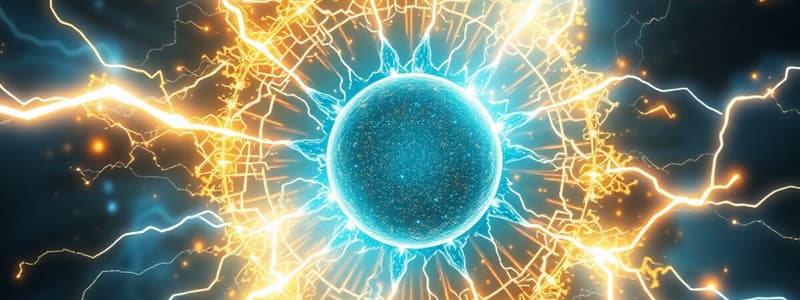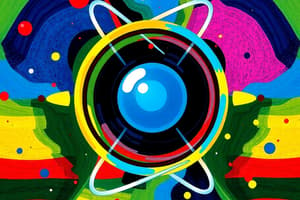Podcast
Questions and Answers
A good electrical insulating material will contain
A good electrical insulating material will contain
- only a small number of free electrons in the outer shell of each atom of the material (correct)
- strongly bound free electrons in the atoms of the material
- weakly bound free electrons in the atoms of the material
The particles that make up an atom are
The particles that make up an atom are
- neutron, electron and ion inclusively
- electron and proton only
- proton, neutron and electron inclusively (correct)
What charge does the nucleus of an atom possess?
What charge does the nucleus of an atom possess?
- neutral
- positive (correct)
- negative
What is a molecule?
What is a molecule?
What is the maximum number of electrons in shell N of an atom?
What is the maximum number of electrons in shell N of an atom?
An atom is
An atom is
If electrons are added to an atom it becomes
If electrons are added to an atom it becomes
When an atom loses or gains an electron it is called.
When an atom loses or gains an electron it is called.
A neutron is a particle which
A neutron is a particle which
An hydrogen atom consist of
An hydrogen atom consist of
The atomic number of an atom is determined by the number of
The atomic number of an atom is determined by the number of
A good electrical insulator is a material which
A good electrical insulator is a material which
The valence electron is
The valence electron is
Copper is a good ______
Copper is a good ______
Electron orbits are also called as
Electron orbits are also called as
A neutral atom gains electrons
A neutral atom gains electrons
Silicon and Germanium both have the properties of being a
Silicon and Germanium both have the properties of being a
A semiconductor will have
A semiconductor will have
Phosphorous and Arsenic are
Phosphorous and Arsenic are
An example of a good electrical insulator is
An example of a good electrical insulator is
A neutron has
A neutron has
An element whose atoms have fewer than 4 electrons in their valency shell are
An element whose atoms have fewer than 4 electrons in their valency shell are
The mass of an atom is contained mainly in the
The mass of an atom is contained mainly in the
Element such as phosphorous with 5 electrons in their outer shell, when combined with pure silicon is a
Element such as phosphorous with 5 electrons in their outer shell, when combined with pure silicon is a
Flashcards
Insulating material
Insulating material
A material that resists the flow of electric current.
Atom components
Atom components
Protons, neutrons, and electrons.
Atomic nucleus charge
Atomic nucleus charge
Positive charge.
Molecule
Molecule
Signup and view all the flashcards
Electron shell N max electrons
Electron shell N max electrons
Signup and view all the flashcards
Atom (definition)
Atom (definition)
Signup and view all the flashcards
Adding electrons to atom
Adding electrons to atom
Signup and view all the flashcards
Electron loss/gain
Electron loss/gain
Signup and view all the flashcards
Neutron
Neutron
Signup and view all the flashcards
Hydrogen atom constituents
Hydrogen atom constituents
Signup and view all the flashcards
Atomic number
Atomic number
Signup and view all the flashcards
Good insulator material
Good insulator material
Signup and view all the flashcards
Valence electron
Valence electron
Signup and view all the flashcards
Copper's property
Copper's property
Signup and view all the flashcards
Electron orbits
Electron orbits
Signup and view all the flashcards
Neutral atom gaining electrons
Neutral atom gaining electrons
Signup and view all the flashcards
Semiconductors
Semiconductors
Signup and view all the flashcards
Semiconductor outer shell electrons
Semiconductor outer shell electrons
Signup and view all the flashcards
n-type dopants
n-type dopants
Signup and view all the flashcards
Insulator example
Insulator example
Signup and view all the flashcards
Neutron properties
Neutron properties
Signup and view all the flashcards
Elements with <4 valence electrons
Elements with <4 valence electrons
Signup and view all the flashcards
Atomic mass location
Atomic mass location
Signup and view all the flashcards
Donor atom (semiconductor)
Donor atom (semiconductor)
Signup and view all the flashcards
AMU
AMU
Signup and view all the flashcards
Study Notes
Electrical Fundamentals - Practice Quiz 1
-
Electron Theory and Static Electricity
- Insulating materials contain few free electrons in the outer shells of their atoms, strongly bound to the atoms.
- Conducting materials contain loosely bound or free electrons, which can freely move.
-
Atomic Structure
- Atoms consist of protons, neutrons, and electrons.
- Protons and neutrons reside within the atomic nucleus.
- The nucleus possesses a positive charge.
- Electrons have a negative charge and orbit the nucleus.
-
Molecules
- A molecule is the smallest particle of a substance that retains its characteristic properties.
-
Electron Shells
- The maximum number of electrons that can be accommodated in shell N of an atom is 32.
-
Atoms
- An atom is the basic building block of matter.
-
Ions
- When an atom gains or loses electrons, it becomes an ion.
-
Neutrons
- A neutron is a particle inside an atom's nucleus, neutral in charge.
-
Hydrogen Atom
- A hydrogen atom is made of one proton and one electron.
-
Atomic Number
- The atomic number of an atom is determined by the number of protons it contains.
-
Insulators
- Good insulators have tightly bound electrons in their outer shells.
-
Valence Electrons
- Valence electrons are electrons situated in the outer shell of an atom.
-
Semiconductors
- Materials like silicon and germanium exhibit properties of being both conductors and insulators.
-
Dopants
- Certain elements, such as phosphorous and arsenic, are used to modify the properties of semiconductors.
- Phosphorous and arsenic make p-type and n-type dopants, contributing to semiconductor behavior.
-
Electrostatic Charges
-
Electrostatic charges are charges on an object/material's surface.
-
Atoms/materials with an opposite charge attract each other.
-
Atoms/materials with the same charge repel each other.
-
Electromagnetic Force
- The force between two charged objects is inversely proportional to the square of the distance between them.
-
Charging Methods
- Friction, induction, and conduction are methods used to charge objects.
-
Static Electricity
- Static electricity refers to an electric charge on the surface of an object.
-
Atomic Mass Unit (AMU)
- Atomic mass unit is the standard measurement of atomic mass
-
Isotopes
- Isotopes are atoms of the same element that have a different number of neutrons.
Studying That Suits You
Use AI to generate personalized quizzes and flashcards to suit your learning preferences.




